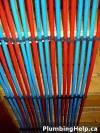There are three types of PEX water distribution systems that can be chosen from according to the homeowners requirements, each having it’s own benefits and drawbacks.
Trunk and branch water supply
The trunk and branch system is the most traditional water distribution system, it consists of a main supply line(trunk) with smaller take-off branches feeding individual or nearby fixtures.
The main advantages of the trunk and branch design are:
- Traditional proven design,
- Lower cost due to faster installation and less materials used,
- Wait time for hot water to multiple fixtures is reduced.
Disadvantages of the trunk and branch design are:
- Pressure loss can be noticed downstream of an open valve,
- Isolating a section of piping will result in multiple fixtures without water,
- Longer wait time for hot water after a period of non use.
Homerun system
 A relatively new plumbing design that has become popular with the use of PEX tubing. Homerun system use multiport manifolds to deliver each fixture with water via dedicated piping.
A relatively new plumbing design that has become popular with the use of PEX tubing. Homerun system use multiport manifolds to deliver each fixture with water via dedicated piping.
Advantages of the homerun system are:
- Less fittings used result in lower pressure losses,
- Isolating a single fixture will not affect other fixtures,
- Smaller diameter tubing may be used thereby reducing the wait time for hot water,
- Less noticeable pressure losses when using multiple fixtures.
Disadvantages of the homerun system are:
- More expensive to install,
- Can look “messy” if installed poorly,
- Each fixture will have to wait for hot water to purge the entire line.
Remote manifold
Just as the name implies; remote manifolds are placed in the water system where multiple nearby fixtures can be serviced, and the manifolds are fed with trunk style supplies.
Advantages of the remote manifold system are:
- Easily designed system,
- Less fittings are used, reducing pressure losses,
- Centrally located valves on the mainfolds.
Disadvantages of the remote manifold system are:
- More expensive than traditional trunk and branch design,
- Access to each remote manifold is required,
- Longer wait time for hot water after a period of non use.
